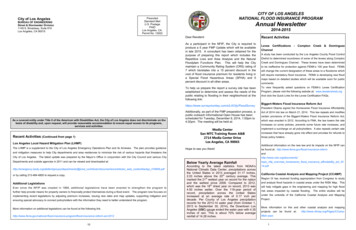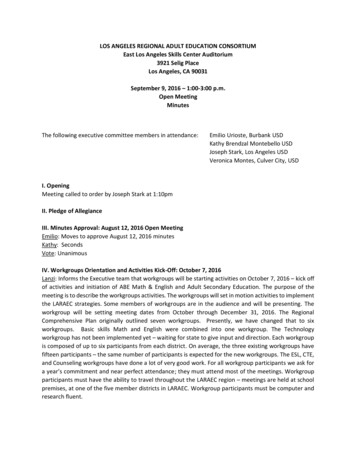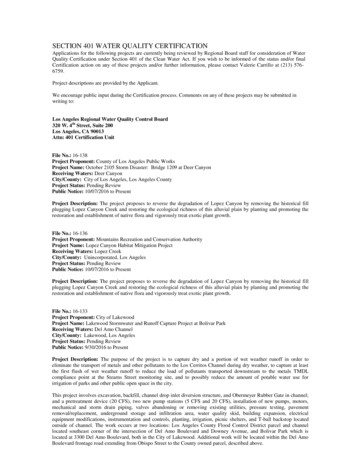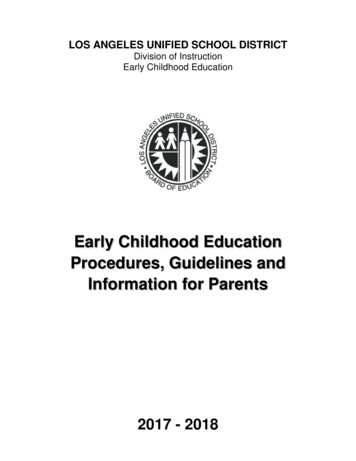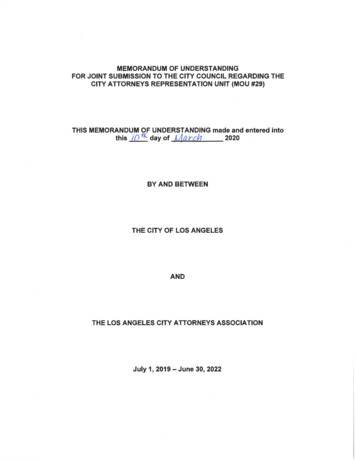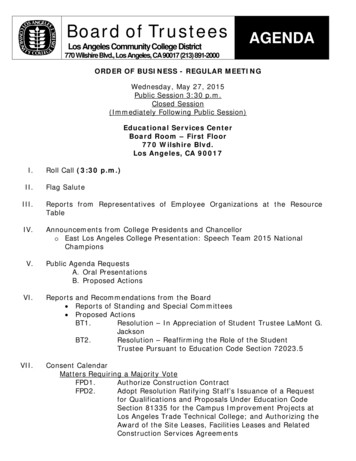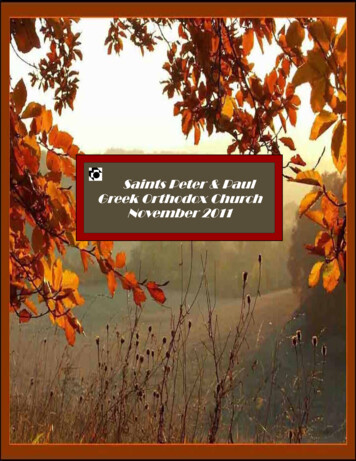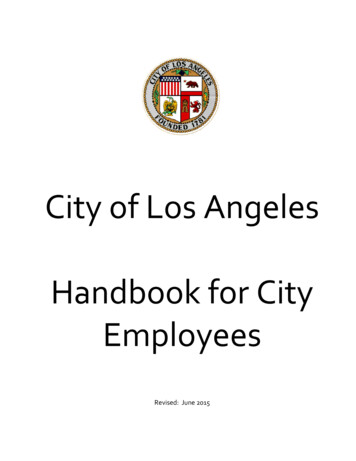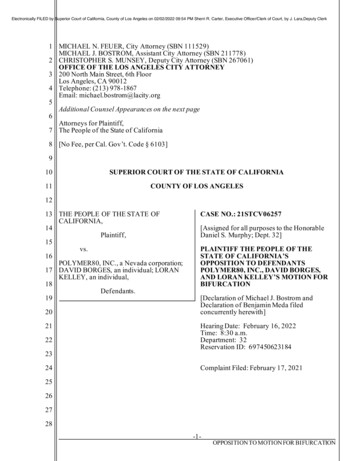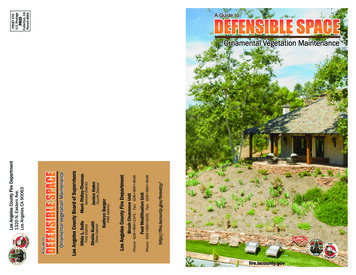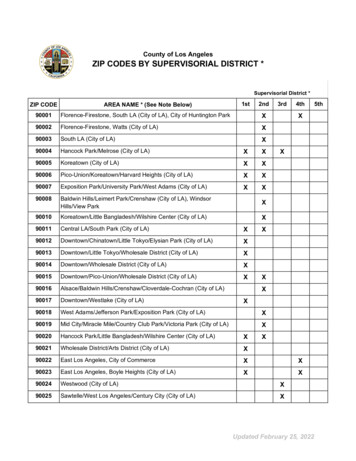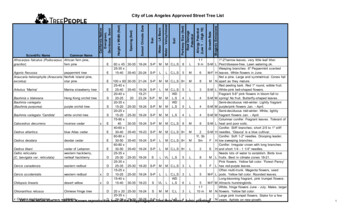
Transcription
EAgonis flexuosapeppermint treeAraucaria heterophylla (Araucaria Norfolk Island pine,excelsa)star pineEArbutus 'Marina'Marina strawberry treeEBauhinia x blakeanaBauhinia variegata(Bauhinia purpurea)Hong Kong orchid treeSpurple orchid treeSBauhinia variegata 'Candida'white orchid treeSCalocedrus decurrensincense cedarCedrus atlanticablue Atlas cedarECedrus deodaradeodar cedarECedrus libaniCeltis reticulata(C. laevigata var. reticulata)cedar of Lebanonwestern hackberry,netleaf hackberryECercis canadensiseastern redbudDCercis occidentaliswestern redbudxDChilopsis linearisdesert willowxDChionanthus retususChinese fringe treex Chitalpa tashkentensisExEDDchitalpaDYELLOW HIGHLIGHTED TREES:Known reproductiveBiogenic EmissionsGrowth RateAllergy Potential(Low 1 - High 10)Root DamagePotentialParkway Size (feet)SoilWater - Valley/InlandWater - LA BasinSunSpacing (feet)Sunset Climate ZoneScientific NameCommon NameAfrocarpos falcatus (Podocarpus African fern pine,gracilior)fern pineHeight x Width (feet)California NativeEvergreen,Deciduous, SemiCity of Los Angeles Approved Street Tree List1"-2"narrow leaves, very little leaf litter.S-M L Pest/disease-free. Lawn watering ok.Weeping branches. 6" Peppermint scentedS-P L L C,L,S 5M6M-F H leaves. White flowers in June.Not a pine. Large and symmetrical. Cones fall100 x 60 30-35 21-24 S-P M M C,L,S 8 M8M N apart as they mature.25-40 xRed peeling bark. Red 1" round, edible fruit.25-40 35-40 18-24 S-P L M C,L,S 5L3S-M L White-pink bell-shaped flowers.20-40 x19,21WDFragrant 5-6" pink flowers in bloom fall to20-252023,24 S-P M M L,S4L4S-M M spring! No fruit. Butterfly-shaped leaves.20-35 xWDSemi-deciduous mid-winter. Lightly fragrant15-20 25-30 18-24 S-P M M L,S5L4S-M M purple/pink flowers Jan. - April.20-25 xSemi-deciduous mid-winter. White, lightly15-20 25-30 18-24 S-P M M L,S4L4S-M M fragrant flowers Jan. - April.75-90 xColumnar conifer. Fragrant leaves. Tolerant of4030-35 18-24 S-P M M C,L,S 8M8S-M L heat and poor soils.40-60 xConifer. Stiff branches; short 2/5 to 1" stiff30-40 35-40 18-23 S-P M M C,L,S 8 M2S-M H needles. 'Glauca' is a blue cultivar.60-80 x1f, 3bConifer. Soft 1-2" needles. Drooping leader,30-50 35-40 18-24 S-P L M C,L,S 8 M5mF H low sweeping branches.60-80 xConifer. Irregular crown with long branches30-50 35-40 18-24 S-P L M C,L,S 8 L2S H and short 1/4 - 1 1/4" needles.25-35 xNeeds lots of water to establish. Birds love25-30 25-30 18-24SL VL L,S5L8M L fruits. Best in climate zones 18-21.25-35 xPink flowers. Yellow fall color. 'Forest Pansy'25-35 25-30 18-20 S-P M M C,L,S 3L5F L has red-purple leaves.15-25 xOften multi-trunk. Magenta flowers, seed10-25 25-30 18-24 S-P L L C,L,S 3L5M-F L pods. Yellow fall color. Rounded leaves.15-40 xWDLong-blooming fragrant, pink trumpet flowers.15-40 30-35 18-23S VL L L,S6L5M-F M Attracts hummingbirds.1fWhite, fringe flowers June - July. Males, larger20 x 20 25-30 18-24SM M C,L3L10 mM N flowers. Yellow fall color.20-35 xLarge pink trumpet flowers. Stake for a few18-24 S-P L L L,S20-3025-304L6FNyears. Aphids on new growth.host of the Polyphagopus Shot Hole Borer. Avoid planting!60 x 45 30-35 18-2425-35 x15-40 35-40 20-24S-PMM C,L,S8L1f9m1
Growth RateM C,L,SWDM C,L,S5M1M5L6M-F5M7S-MMM C,L,SWDM C,L,S5M5S-MSMM6L4MSMM C,L,S3LM25-30 18-24S-PLL C,L,S5M52f9mS-M30-35 19-24S-PM5M5M-F30-35 19-24S-PLM C,L,SWDL L,S4M4M30-35 19-24SMM5M3MRaywood ashDGeijera parvifloraAustralian willowEGinkgo biloba (Male only)Handroanthus impetiginosus(Tabebuia impetiginosa)ginkgo, maidenhair treeJacaranda mimosifoliaLagerstroemia indicacultivarsJacarandaM MS-PMM C,L,SS-PM30-35 18-24SL30-35 18-24S-PM30-35 20-24S35-40 18-24L,SandLaurus nobilisLophostemon confertus(Tristania conferta)Lyonothamnus floribundus ssp.asplenifoliusMacadamia integrifoliaMelaleuca citrina(Callistemon citrinus )Melaleuca linariifoliaMelaleuca (quinquenervia)viridiflora var. rubrifloraMelaleuca saligna (Callistemonsalignus)crape myrtleD25 x 25 25-30 18-21sweet bayEBrisbane boxSanta Cruz islandironwood, CatalinasmoothshellmacadamiaEE40 x 3030-45 x20-4030-60 x20-4025-30 x15-20lemon bottle brushE25 x 2018-24S-PLL C,L,S3L9Fflaxleaf paperbarkES-PLL C,L,S5L7Fcajeput treeE30 x 30 30-35 18-2320-40 x15-30 30-35 20-24S-PLM C,L,S6L7Mwhite bottle brushExE25L,S25 x 15 25-30 18-24 S-P L ? C,L,S 4L9F20-45 xprickly paperbarkE18-24 S-P L M C,L,S 5L7FMelaleucastyphelioides20-35YELLOWHIGHLIGHTED TREES:Known reproductivehostof the 25PolyphagopusShot Hole Borer. Avoidplanting!Biogenic EmissionsAllergy Potential(Low 1 - High 10)FEWDC,L,S 8 S-PRoot DamagePotential3bronze loquatpink trumpet treeParkway Size (feet)LEriobotrya deflexaFraxinus angustifolia (oxycarpa)'Raywood'50 x 60 35-40 18-2425-30 x25-30 25-30 18-2435-50 x20-30 30-35 18-24Soil3EWater - LA BasinMcamphorSun8Spacing (feet)HCinnamomum camphora40 x 2535-80 xD20-6030-50 xD30-40D to 25-40 xS25-40Water - Valley/InlandCommon NameSunset Climate ZoneScientific NameHeight x Width (feet)California NativeEvergreen,Deciduous, SemiCity of Los Angeles Approved Street Tree ListNotesCamphor scented leaves. Massive tree.L Susceptible to Fusarium dieback.White fragrant flowers Dec.-March. 5/8" nonL edible fruit. Best with moist soil.Seedless and smog tolerant. Purple-red fallL color. Small leaflets give refined look.Low maintenance. Deep roots. Pest-free.M Drooping, willow-like, thick leaves.Smog tolerant. Summer water till 10-20' tall.M Yellow fall color. Long-lived.Pink trumpet flowers in late winter/early springM before the leaves.Purple flowers April - Sept. Lots of leaf/flowerL litter. Poor bloom at coast.Orange fall color. Indian cultivars resistL mildew, zones 22-24. Many flower colors.Culinary. Multi-trunk. Scale, psyllids.L 'Saratoga' -25' single trunk, psyllid-resist.Red, peeling bark. White flowers. Not for windyH areas. Smog tolerant.Red, peeling bark. White flowers. NeedsL excellent drainage. Great near the coast.White pendulous flowers. Edible nuts late fallN to May. Best near the coast.Red flowers attract humminbirds. LemonL scented leaves.White flaky bark. Small white summer flowers.H Small, narrow leaves.White, spongy peeling bark. Summer-fall whiteH flowers. Weeping habit.Peeling bark. Cream flowers attractH hummingbirds. Dense canopy.Spongy tan to brown peeling bark. White? spring flowers. Stiff prickly tipped leaves.2
Allergy Potential(Low 1 - High 10)Growth RateHM6SHM10MLVLL,S5WDL C,L,S 6-8WDL L,S4L6FMMM C,L,S3L435-40 18-24S-P VLL C,L,S8M4FN35-40 18-24S-PLM7M4FM35-40 18-24S-PLL C,L,S8M435-40 18-24S-PMML,S8M4M-F LFVF N35-40 18-24S-PLLL,S8 M4M-F N35-40 18-24S-PLM C,L,S 10WDM C,L,S 5WDM C,L,S 4M41f8m1f9m1f9mweeping bottle brushNew Zealand ChristmastreeE25 x 20 25-30 14-24S-PLM C,L,SE30 x 30 25-30 20-24S-PMME30 x 30 25-30 18-24SLD30 x 30 25-30 18-2410-15 x12-20 25-30 18-24SSPinus brutia var. eldaricaOlive (fruitless only)Desert Museum paloverdephotinia,Fraser's photiniaeldarica pine, Afghanpine, Mondell pinePinus canariensisCanary Island pineEPinus halepensisEPinus patulaAleppo pineJelecote pine, Mexicanweeping pineEPinus pineaItalian stone pineEPinus torreyanaTorrey pinePistacia chinensisChinese pistacheDPodocarpus henkeliilong leaf yellow woodEPodocarpus macrophyllusyew pineEPrunus ilicifolia ssp. lyoniiCatalina cherryxEQuercus agrifoliacoast live oakxEMetrosideros excelsusOlea europaeaParkinsonia 'Desert Museum'Photinia x fraseriQuillaja saponariaxEExEsoapbark treeEYELLOW HIGHLIGHTED TREES:Known reproductive65 x 3065-80 x30-4030-65 x4540-80 x30-5040-80 x30-5040-60 x15-30Biogenic EmissionsRoot DamagePotentialFSoil9Water - LA BasinLSun5Spacing (feet)Parkway Size (feet)Water - Valley/InlandCommon NameSunset Climate ZoneScientific NameMelaleuca viminalis (Callistemonviminalis)Height x Width (feet)California NativeEvergreen,Deciduous, SemiCity of Los Angeles Approved Street Tree ListL,SM-F NF60 x 50 35-40 18-23SMLM25-50 x15-202518-24 S-P MLS-F20-50 x15-40 25-30 18-24PM M C,L,S 4LM25-35 x20-30 30-35 18-24 S-P VL VL C,L,S 4L6M20-70 xWD30-85 35-40 18-24 S-P VL L C,L,S 8 M-H9MWD25-60 x18-24 S-P L ? C,L,S 6-8 L10-354Shostof the30-35PolyphagopusShot Hole Borer. Avoid planting!MMLLLHNNotesRed flowers attract butterflies andhummingbirds. Pendulous branches.Red flowers May-July. White leaf underside.Aerial roots. Smog tolerant.Grey-green linear leaves. Round to vaseshaped canopy. Swan Hill no pollen.Yellow flowers attract bees. Light airy canopycover and smooth green bark.White spring flowers. Red new leaves. Noberries. Susceptible to aphids.5"-6" dark green needles. For desert or coast."Christmas tree" shape.Smog tolerant. Tall narrow pine. 9"-12" weepingneedles. 4"-9" cones.Light green, 2½-4" soft needles. Poor soil andheat ok. Susceptible to mites.Graceful, weeping 12" needles. Can becomechlorotic. Great at the coast.Massive, broad-canopied tree. Great at thecoast/valleys. Edible pine nuts.8" - 13" dark gray-green needles. Open habit.OK coastal or high desert.Scarlet & orange fall color. Round 1" to 1 1/2"fruit is red, then blue.Long, drooping linear leaves. Separate maleand female trees. Red flaky bark.Like Afrocapus falcatus , but wider, longerleaves held upright. Red edible fruits.White spring flowers. Edible fruit can be a litterissue.No lawn watering. The most widely used oakfor southern CA.White flowers, better with water. Bark is toxicif eaten. Weeping branches.3
Searsia (Rhus) lanceaAfrican sumacE30 x 30 30-35 18-24S-PLL C,L,S5L47f10 mTipuana tiputipuswamp myrtle, watergumCalifornia bay laurel,California laurelS50 x 50 35-40 18-2420-35 x15-30 20-25 19-2425-75 x20-60 35-40 18-24S-PLM C,L,S 8 M3S-PPShMM C,L,SL5LM C,L,S 6-8M8Tristaniopsis (Tristania) laurinaUmbellularia californicaExE3Biogenic EmissionsLGrowth Rate3Allergy Potential(Low 1 - High 10)Root DamagePotentialWDM C,L,SSoilMWater - LA BasinS-PSun15-25 x8-1015-20 18-24Scientific NameSpacing (feet)ECalifornia NativeEvergreen,Deciduous, SemiRhapiolepis x 'Montic'Common NameMajestic Beauty IndianhawthorneParkway Size (feet)Water - Valley/InlandSunset Climate ZoneHeight x Width (feet)City of Los Angeles Approved Street Tree ListMLMLM-F MSHS-M MYELLOW HIGHLIGHTED TREES: Known reproductive host of the Polyphagopus Shot Hole Borer. Avoid planting!NotesA large shrub with pink flowers. Issues of fireblight, aphids and root rot.Rough cinnamon bark. Heat/wind tolerant.Suckers in youth. No pests.Yellow-orange flowers June-July. Fast. Earlypruning needed. Best with heat.Slow grower. Yellow flowers. Narrow leaves.Shaggy bark. Prefers moist soil.Strong scented leaves ok for cooking. Moreshade/water needed inland.4
City of Los Angeles Approved Street Tree ListTREES NOT RECOMMENDED BY TREEPEOPLE, BUT ARE ON THE STREET TREE LISTAngophora costataArbutus menziesiiArchontophoenixcunninghamianaArecastrum romanzoffianumBetula nigraBetula pendulaBischofia javanicaBrahea armataBrahea edulisBroussonetia papyriferaButia capititaCalodendrum capenseCassia fistula (excelsa)Cassia leptophyllaCastanea mollissimaCastanea sativaCastanospermum australeCasuarina cunninghamianaCatalpa bignonioidesCatalpa speciosaCedrela fissilisCeltis occidentalisking palmqueen palmriver birchEuropean white birchtoog treeMexican blue palmGuadalupe palmpaper mulberrypindo palmCape chestnutcrown of goldgold medallion treeChinese chestnutSpanish chestnutMorton Bay chestnutriver she-oakcommon catalpawestern catalpaBrazilian cedar woodcommon hackberryCorymbia (Eucalyptus) citriodora lemon-scented gumxxxxxxxxHighly FlamableHighly AllergenicxxxxxFruit, Suckers orSelf-seedsMajor pest/diseaseHigh Water UsexxHigh root damagexxWeak branchesNot suited to LAclimate zonesNot readilyavailableHard to establishCommon nameBailey acaciablackwood acaciabigleaf maplebox eldersilk treeItalian alderwhite alderrose gum, gum myrtle,Sydney red gummadrone, madronaToo big for mostparkwaysScientific nameAcacia baileyanaAcacia melanoxylonAcer macrophyllumAcer negundoAlbizia julibrissinAlnus cordataAlnus rhombifoliaCal-IPC InvasiveReasons to remove from listxxxxShort-lived. Polyphagous shot hole borer.Woody fruits are slip hazard. Shedding bark is litterissue late spring & summer. Sap stains.Need rich soil, fast drainage. Only for zone 19.xxxLimited shade. Homeowner can't maintain. PSHB.Limited shade. Homeowner can't maintain.Needs wet to moist soil.Needs wet to moist soil.Only good near the coast. Large, dense tree.Limited shade. Homeowner can't maintain.Limited shade. Homeowner can't maintain.Suckers and spreads, becoming shrubby.Limited shade. Homeowner can't maintain.Moderate water, but needs constant moisture.xxxxxxxxxxVery slow.Needs moist soil.Needs moist soil.Needs moist soil. Poisonous raw fruit. PSHB.Females: cone litter. Males: allergenic pollen.Does best with regular water.Does best with regular water.Related to Ailanthus, possibly invasiveAphid, beetles, caterpillars, powdery mildew.xxxxxxxxxxGeneral NotesShort-lived. 2010 nominated as invasive. PSHB.Polyphagous shot hole borer.Polyphagous shot hole borer.Polyphagous shot hole borer, box elder bugs.Polyphagous shot hole borer.xBranch drop and litter. Spotted gum psyllid.YELLOW HIGHLIGHTED TREES: Known reproductive host of the Polyphagopus Shot Hole Borer. Avoid planting!5
City of Los Angeles Approved Street Tree ListCorymbia (Eucalyptus) ficifoliaCrinodendron pataguaCryptocarya rubraCryptomeria japonicaCupressus glabraCupressus macrocarpaErythrina coralloidesErythrina crista-galliErythrina humeanaEucalyptus camaldulensisEucalyptus cornutaEucalyptus erythrocorysEucalyptus (lehmannii)Eucalyptus leucoxylonEucalyptus nicholiiEucalyptus polyanthemosEucalyptus rudisEucalyptus sideroxylonEucalyptus torquataFicus macrophyllaFicus rubiginosaGleditsia triacanthos inermisHandroanthus chrysotrichus(Tabebuia chrysotricha)red-flowering gumlily of the valley treered cryptocaryaJapanese cedarsmooth Arizona cypressMonterey cypressnaked coral treecockspur coral treenatal coralred gumyatered-cap gumbushy yatewhite ironbarkwillowleaf peppermintsilver dollar gumdesert gumred ironbarkcoral gumMoreton Bay figrusty leaf fighoney locustgolden trumpet treexxxxHighly FlamableHighly AllergenicHigh root damageReasons to remove from listFruit, Suckers orSelf-seedsMajor pests/diseasesHigh Water UseWeak branchesNot suited to LAclimate zonesNot readilyavailableHard to establishCommon nameToo big for mostparkwaysScientific nameCal-IPC InvasiveTREES NOT RECOMMENDED BY TREEPEOPLE, BUT ARE ON THE STREET TREE LISTxxGeneral NotesBranch drop and litter. Borers, root rot and thrips. Forcoast. PSHB host.xSee Hesperocyparis stephensoniiSee Hesperocyparis macrocarpaxxxxxxxxxxxxxxxxxxxxxxxxxxxxxThorns and poison seeds! Often mal-pruned.Thorns and poison seeds! Often mal-pruned.KSHB. Thorns, poison seeds! Often mal-pruned.Branch drop and litter. Red gum lerp psyllid.Branch drop and litter. Red gum lerp psyllid.Branch drop and litter. Red gum lerp psyllid.Branch drop and litter. Red gum lerp psyllid.Branch drop and litter. Red gum lerp psyllid.Branch drop and litter. Red gum lerp psyllid.Branch drop and litter. Red gum lerp psyllid.Branch drop and litter. Red gum lerp psyllid.Branch drop and litter. Red gum lerp psyllid.Branch drop and litter. Red gum lerp psyllid.Extremely invasive roots. Largest Ficus.Large buttress roots.PSHB. Leafs out late and loses leaves early.Beauitiful, but extremely slow. Needs a very welldrained soil.Harpephyllum caffrumKaffir or Mandela plumxVery messy fruit drop.Hesperocyparis (Cupressus)Only for the immediate coast, but still succumbs tomacrocarpaMonterey cypressxcypress canker and insects.Hesperocyparis stephensoniiToo wide for many parkways. Better as a windbreak.smooth Arizona cypress(Cupressusglabra)xxHighly allergenic.YELLOW HIGHLIGHTED TREES: Known reproductive host of the Polyphagopus Shot Hole Borer. Avoid planting!6
City of Los Angeles Approved Street Tree ListHymenosporum flavumIlex altaclerensis 'Wilsonii'Sweet shadeWilson hollyxNeeds rich, moist soil. Transplants poorly.Shrub, not best as a street tree. Fruit drop.xPhoenix canariensisPhoenix dacryliferaPhotinia serratifolia (serrulata )Pinus muricataPinus radiataPittosporum rhombifoliumPittosporum undulatumPlatanus x hispanicaPlatanus racemosaProsopis glandulosaChinese flame treegoldenrain treeprimrose treeJapanese privetOriental sweetgumsweetgumtuliptanbark oakevergreen magnoliaChina berrymyoporumsourgum, tupeloCanary Island date palmdate palmChinese photiniaBishop pineMonterey pineQueensland pittosporumxxxxxxxxxxxxxxxxxxxxxxxxxGeneral NotesLimited shade. Homeowner can't maintain.Polyphagous shot hole borer.Added to invasive watchlist in 2011. PSHB.Seedpods with tiny extremely itchy hairs.Poison leaves and berries, Burns in the sun.Xylella bacteria is lethal. Sudden limb drop.Xylella bacteria is lethal. Sudden limb drop. PSHBHIGH water use in zones 18-21.Killed by Sudden Oak Death. Male flowers stink.Need a moist soil! Xylella bacteria is lethal.Becoming invasive in SoCal. All parts poisonous.Lots of litter. Poisonous fruit.For inland only, but high water use.Limited shade. Homeowner can't maintain.Limited shade. Homeowner can't maintain.Powdery mildew issue. Very shrubby.Susceptible to pitch canker.Shallow roots, blows over. Pitch canker.xxSticky fruit is a nuisance.Sticky fruit litter, invasive roots. Fusarium dieback.xxPSHB, powdery mildew, anthracnose, Fusarium.xxPSHB, powdery mildew, anthracnose, Fusarium.Very thorny, low-growing, shrubby.Twigs, leaves and seeds HIGHLY toxic and may bePrunus carolinanaCarolina cherryxxxfatal if ingested. Fireblight.Attacked by Xylella bacteria and shot hole borers.Prunus cerasiferaPurpleleafplumxxFruit drop.('KrauterYELLOWVesuvius'HIGHLIGHTEDetc)TREES: Known reproductive host of the Polyphagopus Shot Hole Borer. Avoid planting!Victorian boxLondon plane treewestern sycamoremesquitexxHighly FlamableHighly AllergenicHigh root damageReasons to remove from listFruit, Suckers orSelf-seedsMajor pests/diseasesHigh Water UseWeak branchesNot suited to LAclimate zonesNot readilyavailableHard to establishCommon nameChilean wine palmToo big for mostparkwaysScientific nameJubaea chilensisKoelreuteria bipinnataKoelreuteria paniculataLagunaria patersoniiLigustrum japonicumLiquidambar orientalisLiquidambar styracifluaLiriodendron tulipiferaLithocarpus densiflorusMagnolia grandifloraMelia azedarachMyoporum laetumNyssa sylvaticaCal-IPC InvasiveTREES NOT RECOMMENDED BY TREEPEOPLE, BUT ARE ON THE STREET TREE LISTx7
City of Los Angeles Approved Street Tree ListPyrus calleryana a nd cultivarsPyrus kawakamiiOrnamental or floweringpearevergreen pearNarrow branch attachment. Fire blight - some cultivarspartially resistant, but they still get it.Fireblight, whiteflies & aphids.xxIdaho locustblack locustxPeruvian (Calif) pepperxBrazilian pepperxgiant sequoiaxcoast redwoodxfirewheel treeSee Handroanthus chrysotrichusMontezuma cypressxAmerican lindenlittleleaf lindenChinese tallow treexUlmus parvifoliaWashingtonia filiferaWashingtonia robustaChinese elmCalifornia fan palmMexican fan palmxxxxxxxxxxxxxxxxxxxxxxxxHighly FlamableHighly AllergenicRobinia ambigua idahoensisRobinia pseudoacaciaSchinus molleSchinus terebinthifoliusSequoiadendron giganteumSequoia sempervirensStenocarpus sinuatusTabebuia chrysotrichaTaxodium mucronatumTilia americanaTilia cordataTriadica sebifera(Sapium sebiferum)High root damagexxMajor pests/diseasesHigh Water UseWeak branchesNot suited to LAclimate zonesNot readilyavailableHard to establishCommon namescarlet oakEngelmann oakvalley oakcork oaksouthern live oakToo big for mostparkwaysScientific s to remove from listFruit, Suckers -IPC InvasiveTREES NOT RECOMMENDED BY TREEPEOPLE, BUT ARE ON THE STREET TREE LISTGeneral NotesLikes deep, rich, moist soil, moderate water.Polyphagous shot hole borer. Widest canopy oak.Polyphagous shot hole borer. Largest oak.Polyphagous shot hole borer.Susceptible to Xylella bacterial leaf scorch.Poison bark, leaves and seeds. Brittle wood.Poison bark, leaves and seeds. Brittle wood.Not native. Old trees hollow. Leaf/seed litter.Brittle branches and suckers easily.Largest trees in the world. Not appropriate.Needs moister air than southern CA.Needs rich moist soil. Years before blooming.Trunks sometimes 30' wide!xxxxxxMilky sap is poisonous.Nominated for Cal-IPC invasive. Limb drop. Chineseelm anthracnose. Uniformity only.Limited shade. Homeowner can't maintain.Limited shade. Homeowner can't maintain.YELLOW HIGHLIGHTED TREES: Known reproductive host of the Polyphagopus Shot Hole Borer. Avoid planting!8
City of Los Angeles Approved Street Tree ListKeyEvergreen, Deciduous, Semi-deciduousE - Evergreen. The tree has leaves year-round.D - Deciduous. All leaves lost in one season.S - Semi-deciduous. Most, but not all leaves lost.Spacing: Distance from tree to tree, measuredfrom center of trunk to the next trunk center.YELLOW HIGHLIGHTED TREES:These trees are reproductive hosts (the beetle can reproduce inside the tree) of the Polyphagous Shot HoleBorer (PSHB). PSHB is a very small beetle that bores into trees and infects them with a fungus (Fusarium). TheFusarium clogs the cells of the tree, thus blocking the flow of water and nutrients and kills the tree. Because thebeetle attacks many tree species (and more are being added to the list every month), we are advising not toplant the tree species that can harbor these pests. Work is being done by the University of California to findnatural controls. http://ucanr.edu/sites/socaloakpests/Polyphagous Shot Hole Borer/Sunset Climate Zone - From the Sunset Western Garden Book . Zone 24 is the immediate coast, zones 21 - 23 are the L.A. Basin, zones 18 - 20 are the Valley.Sun: S full sun; P part sun/part shade; Sh shadeWater: Ratings from WUCOLS IV (Water Use Classification of Landscape Species http://ucanr.edu/sites/WUCOLS/Plant Search/)LA Basin Sunset Climate Zones 22-24; Valley/Inland Sunset Climate Zones 18-21VL - Very low. Trees should not need water other than natural rainfall. Prolonged drought may require a deep watering once or twice if severe wilting is exhibited.L - Low. One deep watering per summer month, or every other month in dry season if needed.M - Moderate. Two deep waterings per summer month. Perhaps one deep watering in spring and fall.H - High. One deep watering per week in summer months. One deep watering every other dry season month.VH - Very High. The soil needs to be kept moist. These trees naturally occur in riparian zones - stream or lake-side.Soil: C Clay; L Loam; S Sand; WD Well drainedParkway Size (Growing area measureed from curb to sidewalk). This minimum is up to the discretion of the city's street tree inspector.Root Damage Potential - These ratings obtained from the Cal Poly Web site: http://selectree.calpoly.edu. L Low; M Moderate; H HighAllergy Potential - These ratings (1 - 10) from Thomas Ogren's OPALS (Ogrens Plant Allergy Scale) System in Allergy Free Gardening .The increasing incidence of asthma and allergies in the Los Angeles area has prompted us to include this information. Some trees are now outlawed on school campuses because of theirhigh allergy potential. In the flower, it is the male anther that produces pollen, the biggest allergy issue. Most flowers are complete, meaning they have both male and female parts. Somespecies, however, have flowers that are only male or female. These species have either separate male oand female trees (dioecious - two houses), or they have those male-only andfemale-only flowers growing on the same tree (monoecious - one house, like corn), and yet others have separate male and female flowers and also some bisexual flowers. Over the years,male trees have been chosen for street trees and for campuses to avoid the mess of fruit drop from female trees. This has resulted in an increase in male tres, and therefore an increasein pollen.1 lowest rating, least allergenic pollen. If separate male and female trees, these will be the female trees.10 highest rating. These trees are usually wind-pollinated or have very fine pollen grains. If separate male and female trees, these will be the males.f female; m male; b bisexual, having both male and female flowersGrowth Rate: S Slow - up to 12"/year; M Moderate - 24"/year; F Fast - 36"/year; VF Very fast - more than 36"/yearBiogenic Emissions: Some trees emit chemicals that mix with nitrous oxides and create ozone (a main ingredient in smog). These ratings from http://selectree.calpoly.edu.L Low emitters; M Moderate emitters; H - High emitters; N Not listedCal-IPC (California Invasive Plant Council) is a non-profit organization whose mission is to protect California wildands from invasive plants through restoration, research and education.http://www.cal-ipc.org.YELLOW HIGHLIGHTED TREES: Known reproductive host of the Polyphagopus Shot Hole Borer. Avoid planting!9
eldarica pine, Afghan pine, Mondell pine E 35-40 18-24 S-P VL L C,L,S 8 M 4 F N 5"-6" dark green needles. For desert or coast. "Christmas tree" shape. Pinus canariensis Canary Island pine E 35-40 18-24 S-P L M L,S 7 M 4 F M Smog tolerant. Tall narrow pine. 9"-12" weeping needles. 4"-9" cones.
